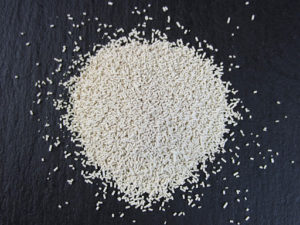APPLICATIONS OF TECHNOLOGY:
- Optimization of sugar conversion from lignocellulosic biomass
BENEFITS:
- Improve profitability of biorefineries that use lignocellulosic biomass as a feedstock by utilizing underused target sugar feedstocks (i.e. 5-carbon pentose sugars) to convert to bioproducts.
BACKGROUND:
- Utilization of different carbon sources in lignocellulosic feedstocks is key to efficiently producing optimal amounts of bioproducts. There is a need for identifying and utilizing novel pathways in the uptake of different feedstock sources.
TECHNOLOGY OVERVIEW:
JBEI researchers at UC Santa Barbara have identified a novel class of microbial membrane transporters that can selectively transport underused sugars into cells to enhance bioproduction.
Researchers identified fungal genes that encode for transporter proteins from the Sugars Will Eventually be Exported Transporter (SWEET) family. Transporter activity was screened in the yeast Saccharomyces cerevisiae. NcSWEET1, a novel Neocallimastix californiae SWEET protein sourced from anaerobic fungi, localized to the plasma membrane of yeast and promoted growth utilizing both hexose sugars and xylose. The novel yeast strain utilized 40.1% of both sugars, a 22.8% increase in sugar utilization compared to the control strain. The wildtype NcSWEET1 protein, and engineered versions of the protein, permitted co-utilization of glucose and xylose sugars in the microbial host, indicating a residue-specific substrate intake activity that can guide engineering efforts to further regulate sugar transport.
JBEI is looking for an industry partner that will collaborate with researchers to optimize this system in suitable microbial hosts.
DEVELOPMENT STAGE: Proven principle
FOR MORE INFORMATION:
PRINCIPAL INVESTIGATORS:
STATUS: Patent pending.
OPPORTUNITIES: Available for licensing or collaborative research.
SEE THESE OTHER BERKELEY LAB TECHNOLOGIES IN THIS FIELD:
Engineering S. cerevisiae to Produce Isoprenol for Sustainable Aviation Fuel and Chemicals 2020-086
